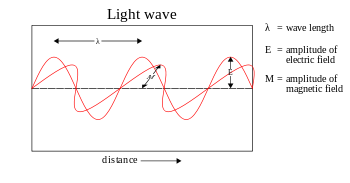 Photography
Photography What is Photography?
I personally interpret photography as a visual art to produce beautiful images that have meaning and intent in it using a camera.
According to Spencer, D A (1973) in his book entitled "The Focal Dictionary of Photographic Technologies", Photography is the science, art, application and practice of creating durable images by recording light or other electromagnetic radiation, either electronically by means of an image sensor, or chemically by means of a light-sensitive material such as photographic film.source
 Light Wave
Light Wave As a general term, photography means a process or method for generating images or photographs of an object by recording the reflection of light that objects to it on a light-sensitive medium. The most popular tool to capture this light is the camera. Without light, no photo can be made.source
So, photography can be interpreted as a technique or practice in recording the reflection of light received by an object to produce images or photographs.
The Basics of Photography to be Learned
1. Understanding the Camera
It is impossible to start studying photography when not understanding the camera and how to use the camera. Understanding the camera is the first thing to do, because a camera will affect the resulting photo. Apply the use of the camera on everyday activities to understand better settings and usage.
2. Understanding of Exposure
 Exposure Cheat Sheet
Exposure Cheat Sheet Aperture
Aperture is the hole within your lens, through which light travels into the camera body.source
Shutter Speed
Shutter speed, also known as “exposure time”, stands for the length of time a camera shutter is open to expose light into the camera sensor. If the shutter speed is fast, it can help to freeze action completely, as seen in the below photos. If the shutter speed is slow, it can create an effect called “motion blur”, where moving objects appear blurred along the direction of the motion which you can also see in the below photo.source
ISO
In very basic terms, ISO is the level of sensitivity of your camera to available light. The lower the ISO number, the less sensitive it is to the light, while a higher ISO number increases the sensitivity of your camera. source
3. Understand Shooting Modes
Shooting Mode image source

Shooting mode is a choice of settings provided in the camera that can be used depending on the conditions and circumstances. Shooting mode is divided into 3, namely :
Automatic Mode
AUTO Mode : AUTO mode instructs the camera to use the best 'ratings' in determining Shutter Speed, Aperture, ISO, White Balance, Focus and flash to get the best results.source
Portrait Mode : the camera will automatically select using Aperture that produces photos with an unfocused or blurry background.source
Macro Mode : Macro Mode Settings to take photos closer to the subject to take close-up shots.source
Landscape Mode : This shooting mode can be said to be the reverse of Portrait mode, where Landscape mode setting gives a small Aperture (large number) to ensure that as many areas of the portrait will be focused (Depth of Field width / large).source
Sports Mode : Moving a moving object is a major function of the Sports mode (on some cameras it is called 'action mode').source
Night mode : Night mode (the technique can be called 'slow shutter sync') is used in low light shooting, and uses longer shutter speeds on the camera to help record background details but can also use flash to provide light on the foreground (subject).source
Movie Mode : This mode feature is an 'extension' of the camera's ability from just taking pictures to recording motion pictures.source
Semi Automatic Mode
Aperture Priority (A or AV) Mode : Manually select Aperture and the camera will select another setting (Shutter Speed, White Balance, ISO, etc.) to get the right exposure.source
Shutter Priority Mode (S or TV) : To have full control on Shutter Speed, and the camera will handle the rest of the settings.source
Program Mode (F) : Program Mode is similar to AUTO, in cameras that have both AUTO and Program Mode, the Program mode gives little control or control over some camera features such as flash, White Belance, ISO, and others.source
Full Manual Mode
Manual Mode : Full control and control in determining all setting parameters such as Shutter Speed, Aperture, ISO, White Balance, and others. This mode provides the flexibility of the settings used in shooting. source
4. Learn 2 Basic Photography Techniques
The two techniques are Image Taking Technique (Type of Shot) and angle technique of shooting (Camera Angle).
Reference :
www.udemy.com
Wikipedia (Photography)
Wikipedia (Cahaya)
Wikipedia (Fotografi)
Artfvisuals.com
hobifotografi.com
infotografi.com
@awonk >> I previously thought of ordinary photography, but after I read your article I got a good lesson from your article. to understand photography should learn the basics of photography first
Your Post Has Been Featured on @Resteemable!
Feature any Steemit post using resteemit.com!
How It Works:
1. Take Any Steemit URL
2. Erase
https://3. Type
reGet Featured Instantly – Featured Posts are voted every 2.4hrs
Join the Curation Team Here
Your Post Has Been Featured on @Resteemable!
Feature any Steemit post using resteemit.com!
How It Works:
1. Take Any Steemit URL
2. Erase
https://3. Type
reGet Featured Instantly � Featured Posts are voted every 2.4hrs
Join the Curation Team Here | Vote Resteemable for Witness